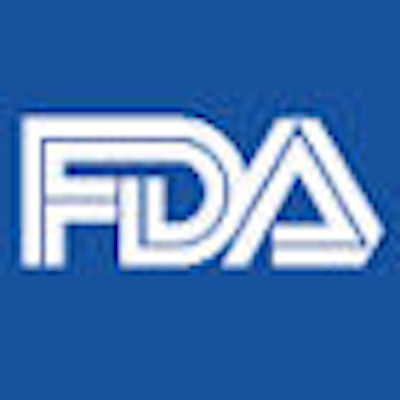
The U.S. Food and Drug Administration (FDA) has raised the ante in its drive to reduce pediatric radiation dose, launching a new program that will require manufacturers to consider the safety of children when designing new x-ray imaging devices. Devices that do not comply with the program may have to carry warning labels advising against their use in children.
The FDA's move is the culmination of several years of meetings and deliberation on the radiation dose issue, which has come to a head in recent years. While the program could be seen as an expansion of the agency's traditional role in overseeing medical devices, radiologists and the vendor community are welcoming the initiative as an important step in assuaging the public's concerns regarding the safety of medical imaging.
General use vs. pediatric-specific
FDA background documents on the new program note that most x-ray imaging devices are marketed with general indications-for-use statements that don't address the unique issues associated with pediatric use, or contain any specific labeling for pediatric patients. But the use of ionizing radiation in children is of specific concern, it says, for three reasons:
- Younger patients are more sensitive to radiation than adults.
- Younger patients have longer expected lifetimes for the effects of radiation to manifest into cancer.
- The use of equipment and exposure settings designed for adults can result in excessive radiation doses in children.
As the first step in its new push, the FDA is collecting public comments on suggestions for implementing the requirement that manufacturers consider the safety of children in the design of all new x-ray imaging devices, including CT and fluoroscopy devices. A workshop scheduled for July 16 to discuss the guidance will bring together industry, patient advocates, and x-ray imaging equipment users, including physicians, radiologic technologists, and medical physicists.
"Experts have commented that many radiological devices are sold without the design features or labeling information that would help users optimize benefit (clinically usable images) in comparison to risk (radiation exposure) for pediatric imaging," the FDA wrote. The agency noted that existing equipment can be used safely by consulting recommendations provided by the Alliance for Radiation Safety in Pediatric Imaging (ARSPI), with whom the agency is partnering, and the Medical Imaging and Technology Alliance (MITA), which will develop pediatric imaging radiation safety training materials.
Because of the special concerns about excessive exposure to radiation in children, the agency has declared with this initiative that new x-ray imaging devices must be shown to be appropriate for pediatric use -- or users should be cautioned against use in pediatric populations. Armed with this information, end users can then make more informed decisions about using the device on pediatric patients, the FDA said.
Scanner manufacturers' 510(k) submissions should begin by defining indications for use and pediatric populations for whom use is intended, the agency proposed. If use of the device is not intended for children, the indications for use should contain the statement "CAUTION: Not for use on patients less than approximately [insert patient size in body part thickness or weight and height]," the FDA wrote.
Manufacturers seeking marketing clearance for new devices should also provide data supporting the safety and effectiveness of their devices in children. While height and weight are readily available methods to describe average-sized patients, patient thickness is the most useful metric for x-ray imaging, the agency noted.
The guidance document can be viewed by clicking here.
A new step
The move represents the FDA's latest step in a pediatric imaging initiative that began more than eight years ago. The agency ramped up its focus on pediatric radiation following several widely publicized incidents of radiation overdoses, such as a Northern California boy who received 151 CT scans in a single session in 2008. The scans left a band of bright red skin across the boy's head.
At a meeting in 2010, the FDA sought advice on steps that CT and fluoroscopy manufacturers could take to reduce unnecessary radiation through better product design, labeling, instructions for use, and improved instructions and training at facilities where the systems are used.
In response to the 2010 meeting, the FDA received recommendations including development of specific pediatric protocols, quality assurance tools for facilities emphasizing radiation dose management, dose information applicable to pediatric patients, and an expanded range of features available on x-ray imaging devices.
The new FDA initiative is focusing on that final recommendation -- expanded range of features -- saying it considers the 2010 recommendations "appropriate" for moving forward. The proposal for new devices includes consideration of the following features for most equipment:
- Specific preset pediatric control settings that are appropriate for the intended patient
- Pediatric procedures, labeling, and protocols that are designed to minimize radiation exposure while providing image quality of acceptable clinical value
- Display and recording of patient dose or dose index and ability to record other patient information, e.g., age, height, and weight (either manual entry or automatic calculation)
- Software interface features that alert the end user to important pediatric use issues (e.g., interactive software pop-ups that remind users of special pediatric issues when setting up the image acquisition)
The FDA is asking that public comments be submitted within 120 days of the date the notice announcing the availability of the draft guidance is published in the Federal Register. Electronic comments should be submitted to regulations.gov and marked with the docket number that will be listed in the published notice of availability.
Experts applaud program
Experts in pediatric radiation dose are applauding the FDA's move. MITA said it welcomed the program's focus on children, but that it also advocates for the implementation of physician-developed appropriateness criteria for all patients and the mandatory accreditation of imaging facilities. MITA also supports a mandatory dose registry to track patient radiation exposure.
Dr. Rebecca Smith-Bindman of the University of California, San Francisco sees the new program as a good place to start, and as something of a shift in the FDA's mission. She noted that historically the FDA has limited its regulatory oversight to providing review and approval of medical technology, rather than regulation of how that technology is used by physicians.
"This is well within their legislative mandate, but this is an expansion of what they have been regulating," she told AuntMinnie.com. "It doesn't make sense to release new equipment and not train the people who are using it, and test it in how it's going to be used. These things are long, long overdue."
Smith-Bindman also said that the new initiative targets the routine use of radiation for pediatric imaging, which is just as big an issue as the cases of severe radiation overdoses that grab headlines. Many facilities simply aren't adapting their routine scanning protocols to children; as a result, pediatric radiation dose levels can vary widely -- even within the same institution.
In fact, Smith-Bindman's group has submitted a paper to the Journal of the American Medical Association that documents wide variations in dose levels for thousands of pediatric scans.
"Doses are much higher than needed for diagnosis, and these are routine scans," Smith-Bindman said. "The way we scan children is in no way tailored [to them]."
Dr. Marilyn Goske of Cincinnati Children's Hospital Medical Center sees the new program as a culmination of the past several years of work in radiation dose awareness, as exemplified by the Image Gently campaign but also by the numerous meetings that have been held between providers and the FDA.
"We're thrilled with the FDA guidance document, it's well thought-out and addresses many of the issues we thought should be addressed," Goske told AuntMinnie.com. "It highlights the importance of when the engineers and physicists are developing equipment, they should be asking themselves, how is this going to be used in children, and are there ways to make this even safer?"
Goske noted that while manufacturers are making progress on their own toward "child-sizing" radiation dose, such collaboration is necessary given the rapidly changing nature of CT technology.
"The position of the Image Gently campaign has been that we want to be as cautious as we can in using [radiation] in children, recognizing that the benefits of medical imaging are many," Goske said. "Parents shouldn't hesitate in having scans [performed on their children], but what can we do to make them as safe as possible?"




















